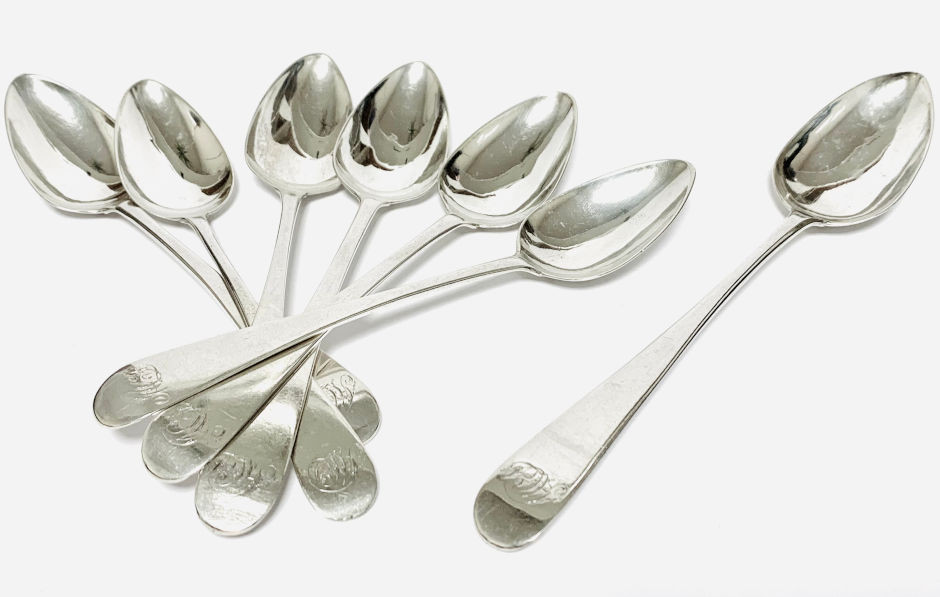
Antique silver spoons represent a wide and varied area of collectables and are a great choice for the novice collector. Pre-dating the table fork, which didn’t come into general use until the 1700s, the spoon was originally a portable, widely used utensil specifically for eating. Over time, the spoon went on to serve specific functions including measuring spices and condiments such as salt, preparing liquid foodstuff, and basting meat.
However, there has never been a collectable silver item that has been produced in the same numbers as antique spoons, so the novice collector needs to do a little research before starting their silver spoon collection.
How to date an antique silver spoon
Collectors should look first at the shape and proportions of the spoon. Up to the 18th century, spoons were fashioned from two pieces – the stem and the bowl – which were then joined together. From the 18th century, spoons were formed from a single piece, so a spoon of two parts is likely to be an early example.
Hallmarks will also help you to date silver spoons. Edward I (1272-1307) decreed that all silver items should contain 92.5% pure silver and introduced the hallmarking system to ensure this. Our blog Silver Hallmarks: how to tell if your silver is antique has more information, including where to look for hallmarks; on silver spoons, the hallmark will be on the back of the handle, below the bowl.
Types of antique silver spoons
Once the spoon had evolved to take on different functions, the types available became diverse and many collectors will specialise in a particular type of antique silver spoon, rather than having a collection of different types. For example, you may choose to collect silver teaspoons alongside silver caddy spoons, or you could concentrate on silver salt spoons, or silver condiment spoons and jam spoons. Other types of antique spoon include serving spoons, ladles and basting spoons, as well as antique silver baby spoons.
This vast amount of silver spoon types that are available to collect may make them a daunting area of collectables for the novice. A little research will go a long way and these are just some of the areas a collector can choose to specialise in.
Collections of silver spoons by date
Generally there are two ways to collect silver spoons by date. The easier way, particularly for the novice collector, is to focus on a collection that is representative of a specific time frame, for example Georgian spoons. The more challenging approach to collecting by date is to choose spoons that date from every year within a specific period, for example the 18th century.
Collections of silver spoons by area of origin
Collecting silver spoons from a particular area is a great starting point for a new collection and many people will choose an area that has meaning to them. For example, a Yorkshireman may want to specialise in pieces hallmarked in Sheffield. Some geographical areas, such as Leeds and Norwich will command higher prices as production there stopped in 1700. Similarly, pieces hallmarked in historic assay offices (York, Exeter, Newcastle, Chester and Glasgow) that are no longer in existence are highly sought after.
Collections of silver spoons by maker
Silver spoons from certain makers will be valued higher, and are therefore more collectable, than spoons from their contemporaries. This can be linked to reputation, quality of work and design. Makers of repute to look for include Garrard, Elkington, Storr of Chawner & Co., and Jensen.
Collections of silver spoons by form (design/pattern)
A spoon’s ‘form’ refers to the design or style of the piece and some collectors focus on particular antique silver spoon patterns, with rarer patterns commanding higher prices. Popular patterns include the fiddle pattern where plain handles are shaped like a violin, the shell pattern which can adorn one or both sides of the handle, and the bead pattern where a simple beaded decoration outlines the shape of the handle. The most recognisable and collectable form for a silver spoon is the Apostle spoon, which bears the figure of an apostle on its handle. Dating to pre-Reformation, Apostle spoons were traditionally gifted to children by their godparents and can command healthy prices; in 2008 an apostle spoon featuring St Matthias by spoon-maker William Simpson (1515), achieved £28,000 at auction.
Antique silver spoons form beautiful collections that represent so many things – historical periods, styles, individual silversmiths – and the diverse selection of types of spoon can help the collector to amass an interesting collection. There are types of spoon that can be found easily but are more expensive (basting spoons, caddy spoons), others that are available aplenty and are reasonably priced, enabling the beginner to kickstart a collection quite quickly (condiment spoons), and those that are not only harder to find but that are more expensive. This latter group includes medicine spoons and mote spoons, a slotted spoon that served the same purpose as a tea strainer.
At Hemswell Antique Centres, our dealers have silver spoons of every type, to suit every budget and many of them can be posted to you for just £15.